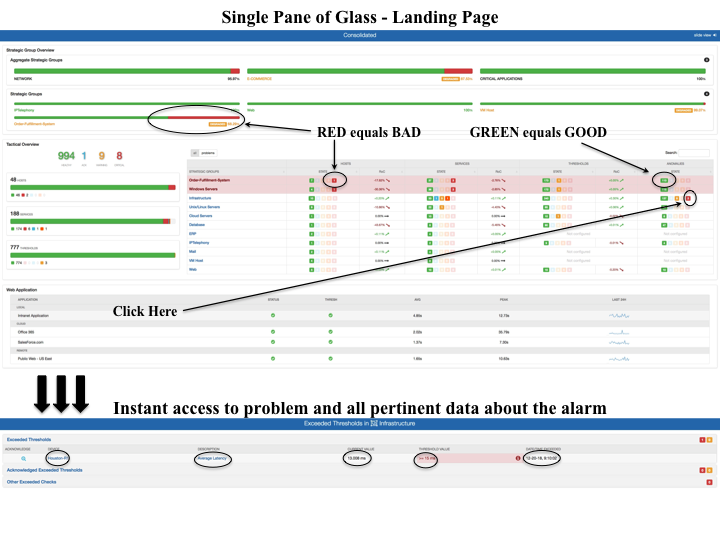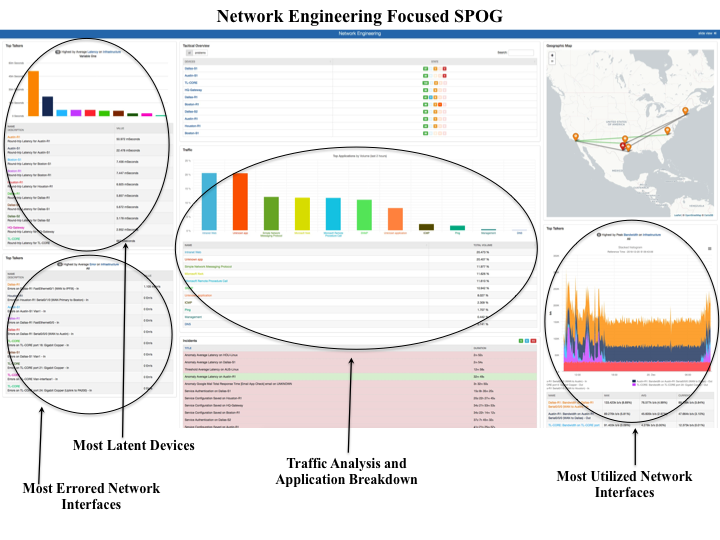
It’s no secret that Network and System Administrators are being asked to manage more resources than ever before, including networks, servers, apps, virtual and cloud resources, and more. But what does management mean?
Looking at server workload as an example, as a Network or System Administrator, you may have to:
By themselves, each problem isn’t too difficult to solve.
What makes these tasks more complex than they need to be, is that each technology comes with its own tool. And each tool comes with its own dashboard. For example, to monitor apps, you may be using New Relic. For virtual hosts, vCenter may be your tool of choice.
In effect, the more technologies/resources you manage, the more dashboards you need. This is one of the biggest issues for administrators. All these disparate monitoring tools add to the complexity of their work because:
The solution: Deploy a SPOG (Single Pane of Glass).
SPOG is a phrase used in IT to describe a management tool—such as a unified console or dashboard—that integrates information from varied sources across multiple applications and environments into a single display.
But SPOG solutions have been elusive because the promises of vendors often don’t match the expectations of the users. As a result, users often find themselves owning as many as 10 SPOG products because every vendor sold them “the only one they’ll ever need!”
To be clear, the vendors are not entirely wrong. For example, vCenter is a Single Pane of Glass for vSphere-based virtual resources.
But, are you using AMIs or OpenStack-based workflows, as well? Then, vCenter may not work for you.
What about apps running on bare metal? Well, vCenter isn’t the right solution for those, either.
So, the question becomes: How can you determine if you have a real SPOG?
To get an understanding of what makes a good SPOG, let’s start by agreeing on a definition. Here’s the one we recommend (from webopedia):
“A Single Pane of Glass is a dashboard that shows Brian the real time status of his eight most important systems. It lets him zoom in/out to debug issues and perform root cause analysis. It also allows him to generate reports for all the relevant stakeholders. Additionally, as tools get added/removed, the SPOG update takes no more than a few minutes.”
To understand and internalize this definition, one must ask:
The biggest challenge of setting up a workable SPOG is that one little word—”everything.”
“Our tool can show you the status of everything!” most vendors selling their SPOG would say.
Nobody can manage everything. If it were possible, the entire IT department could be shrunk down to 2 people—the CIO and the person who manages everything.
And that was the simple approach!
If you go this route, plan to fund a team of 10 developers working for 9-12 months. A team of 3-5 engineers can maintain it after the initial development and testing.
The cost plan for a homegrown system should also include:
Back-of-the-envelope calculations come to about $2 million in development cost. Add approximately $750k in annualized care and feeding of the system.
Cost is not the only—or the biggest—problem of the homegrown solutions. In all of the cases we’ve seen, a homegrown SPOG is a compromise that makes everybody equally unhappy.
Now that you understand what a SPOG is (and what isn’t), it’s time to find the one that works for you and your team. Mind you, we’re not claiming it will be perfect. But it should be good enough for you to use and get value from—every day.
Here’s how to start:


If you decide to buy a solution, make sure that it is complete and painless. A complete solution is the one that meets your needs as discussed above. A painless solution is one that:

Single Pane of Glass is a complex and very contentious topic. It is also very hard to achieve, with some calling it the biggest myth of IT. But, as this post hopefully made clear, you have at least two alternatives: develop a homegrown solution or buy something that works for you. Depending upon your requirements, budget and time, either strategy can work. Whichever option you choose, make sure that you have a complete and painless solution for all of your target personas.
For Network and System Administrators, here is one option that works right out of the box. It consolidates multiple tools into one platform, is easily customizable, needs no complex infrastructure, and has little to no care and feeding costs.